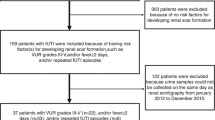Abstract
Objective
To investigate if serum C-reactive protein (s-CRP) and interleukin 6 (s-IL6) provide information for predicting renal damage and for DMSA patient selection in children with urinary tract infection (UTI).
Methods
This observational study was carried out in children with UTI. s-CRP and s-IL6 were measured at UTI diagnosis. Patients forming renal scarring were identified by DMSA scans. The usefulness of s-CRP and s-IL6 measurements for nephropathy scarring diagnosis was evaluated using diagnostic quality and efficiency indexes.
Results
Thirty-two children were included in the study. Eight showed renal scarring after the follow-up. The s-CRP was 110.23 ± 59.69 mg/L and 52.46 ± 63.13 mg/L for patients with and without renal scarring. The s-IL6 concentration was 18.34 ± 11.80 pg/mL and 8.07 ± 9.51 pg/mL respectively. The cut-off points for optimum nephropathy scarring diagnosis were 115 mg/L for s-CRP and 20 pg/mL for s-IL6. The value of highest sensitivity for s-CRP was >5 mg/L (S:100 %) and greatest specificity was >150 mg/L (Sp:95.83). The highest sensitivity for s-IL6 was >4 pg/mL (S:100 %) and the maximum specificity was >40 pg/mL (Sp:100 %).
Conclusions
Results confirm that children who will develop renal scarring show higher levels of s-IL6 and s-CRP at UTI diagnosis. However, none of the techniques provide sufficient information for predicting renal damage in all patients and for DMSA patient selection

Similar content being viewed by others
References
Espinosa L. Infección urinaria. In: García Nieto V, Santos F, Rodríguez I, eds. Nefrología pediátrica. 2nd ed. Madrid: Aula Médica; 2006. pp. 507–20.
Rushton HG. Urinary tract infection in children. Epidemiology, evaluation and management. Pediatr Clin North Am. 1997;44:1133–69.
Navarro M, Espinosa L, Fernández C. Neuropatía cicatricial. In: García Nieto V, Santos F, Rodríguez I, eds. Nefrología pediátrica. 2nd ed. Madrid: Aula Médica; 2006. pp. 535–43.
National Institute for Health and Clinical Excellence (NICE). Urinary tract infection in children. (http://guidance.nice.org.uk/CG054). 2007.
Coulthard MG, Lambert HJ, Keir MJ. Do systemic symptoms predict the risk of kidney scarring after urinary tract infection? Arch Dis Child. 2009;94:278–81.
Huang DT, Huang FY, Tsai TC, Tsai JD, Chiu NC, Lin CC. Clinical differentiation of acute pyelonephritis from lower urinary tract infection in children. J Microbiol Immunol Infect. 2007;40:513–7.
Garin EH, Olavarria F, Araya C, Broussain M, Barrera C, Young L. Diagnostic significance of clinical and laboratory findings to localize site of urinary infection. Pediatr Nephrol. 2007;22:1002–6.
Sheu JN, Chen MC, Chen SM, Chen SL, Chiou SY, Lue KH. Relationship between serum and urine interleukin-6 elevations and renal scarring in children with acute pyelonephritis. Scand J Urol Nephrol. 2009;43:133–7.
Rodríguez LM, Marugán JM, Suárez MA, Torres MC. Citoquinas en la patología nefrourológica pediátrica. Arch Latin Nefr Ped. 2003;3:73–81.
Gürgöze MK, Akarsu S, Yilmaz E, Gödekmerdan A, Akça Z, Ciftçi I, et al. Proinflammatory cytokines and procalcitonin in children with acute pyelonephritis. Pediatr Nephrol. 2005;20:1445–8.
Robles B, Rodríguez LM, Suárez MA, Marugán JM, Fernández M, de Fuentes MC. Comparación de la utilidad de la fiebre y de algunos parámetros analíticos para el diagnóstico de pielonefritis aguda en niños. Rev Esp Pediatr. 2005;61:358–63.
Otto G, Braconier J, Andreasson A, Svanborg C. Interleukin-6 and disease severity in patients with bacteremic and nonbacteremic febrile urinary tract infection. J Infect Dis. 1999;179:172–9.
Rodríguez LM, Robles B, Marugán JM, Suárez A, Santos F. Urinary interleukin-6 is useful in distinguishing between upper and lower urinary tract infections. Pediatr Nephrol. 2008;23:429–33.
Roilides E, Papachristou F, Gioulekas E, Tsaparidou S, Karatzas N, Sotiriou J, et al. Increased urine interleukin-6 concentrations correlate with pyelonephritic changes on 99mTc-dimercaptosuccinic acid scans in neonates with urinary tract infections. J Infect Dis. 1999;180:904–7.
Patel K, Charron M, Hoberman A, Brown ML, Rogers KD. Intra- and interobserver variability in interpretation of DMSA scans using a set of standardized criteria. Pediatr Radiol. 1993;23:506–9.
Roushton HG. The evaluation of acute pyelonephritis and renal scarring with technetium 99m-dimercaptosuccinic acid renal scintigraphy: Evolving concepts and future directions. Pediatr Nephrol. 1997;11:108–20.
Yang H, Carlin D. ROC surface: A generalization of ROC curve analysis. J Biopharm Stat. 2000;10:183–96.
Jacobson SH, Eklöf O, Lins LE, Wikstad I, Winberg J. Long-term prognosis of post-infectious renal scarring in relation to radiological findings in childhood—a 27-year follow-up. Pediatr Nephrol. 1992;6:19–24.
Jakobsson B, Berg U, Svensson L. Renal scarring after acute pyelonephritis. Arch Dis Child. 1994;70:111–5.
Stokland E, Hellström M, Jacobsson B, Jodal U, Sixt R. Renal damage one year after first urinary tract infection: Role of dimercaptosuccinic acid scintigraphy. J Pediatr. 1996;129:815–20.
Kishimoto T. Interleukin-6 and its receptor; From cloning to clinic. Int Arch Allergy Immunol. 1992;99:172–7.
Sheu JN, Chen MC, Lue KH, Cheng SL, Lee IC, Chen SM, et al. Serum and urine levels of interleukin-6 and interleukin-8 in children with acute pyelonephritis. Cytokine. 2006;36:276–82.
Prat C, Domínguez J, Rodrigo C, Giménez M, Azuara M, Jiménez O, et al. Elevated serum procalcitonin values correlate with renal scarring in children with urinary tract infection. Pediatr Infect Dis J. 2003;22:438–42.
Bressan S, Andreola B, Zucchetta P, Montini G, Burei M, Perilongo G, et al. Procalcitonin as a predictor of renal scarring in infants and young children. Pediatr Nephrol. 2009;24:1199–204.
Tullus K, Fituri O, Linné T, Escobar-Billing R, Wikstad I, Karlsson A, et al. Urine interleukin-6 and interleukin-8 in children with acute pyelonephritis, in relation to DMSA scintigraphy in the acute phase and at 1-year follow-up. Pediatr Radiol. 1994;24:513–5.
Conflict of Interest
None.
Role of Funding Source
This study was financed with the grant number nº 97/1125 from “Fondo de Investigaciones Sanitarias”. Gobierno de España.
Author information
Authors and Affiliations
Corresponding author
Rights and permissions
About this article
Cite this article
Rodríguez, L.M., Robles, B., Marugán, J.M. et al. Do Serum C-reactive Protein and Interleukin-6 Predict Kidney Scarring After Urinary Tract Infection?. Indian J Pediatr 80, 1002–1006 (2013). https://doi.org/10.1007/s12098-013-1045-4
Received:
Accepted:
Published:
Issue Date:
DOI: https://doi.org/10.1007/s12098-013-1045-4




